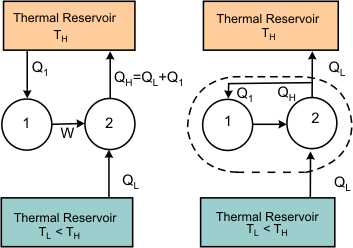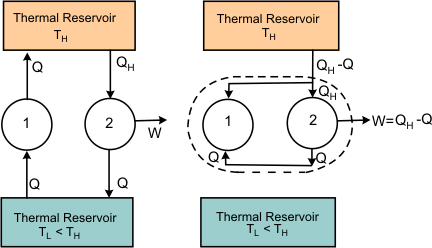Clausius Statement of the Second Law (contd...)
Let us suppose that the Kelven Planck statement is incorrect.

Figure 17.3
Refer to Figure 17.3 that is, it is possible to construct a device I which, working cyclically, absorbs energy a heat  from a source at temperature from a source at temperature  and performs an equivalent amount of work and performs an equivalent amount of work  . Next consider a device II which absorbs . Next consider a device II which absorbs  amount of energy from a low temperature body at amount of energy from a low temperature body at  and delivers energy as heat and delivers energy as heat  to a high temperature reservoir at to a high temperature reservoir at  . To accomplish this, work . To accomplish this, work  is done on the device. The device II does not violate the Clausius statement. For device II, we can write is done on the device. The device II does not violate the Clausius statement. For device II, we can write  . Now combine I and II. The work delivered by device I is used by device, II. . Now combine I and II. The work delivered by device I is used by device, II.
Then

|
(17.1) |
 |
(17.2) |
This combined device (which is no more aided by any external agency) working cyclically, is not producing any effect other than the transfer of energy as heat  from the low temperature reservoir to the high temperature reservoir. This is in violation of the Clausius statement. from the low temperature reservoir to the high temperature reservoir. This is in violation of the Clausius statement.

Figure 17.4
To prove that violation of the Clausius' statement leads to violation of Kelvin Planck statement, let us assume that the Clausius' statement is incorrect. That is, it is possible to constructs a device I (refer to Figure 17.4) such that it transfers energy as heat  from a body at lower temperature to a body at higher temperature unaided by any external agency. Consider another device II which receives energy as heat from a body at lower temperature to a body at higher temperature unaided by any external agency. Consider another device II which receives energy as heat  from a body at higher temperature, delivers work from a body at higher temperature, delivers work  and rejects energy as heat and rejects energy as heat  to the body at a low temperature. Device II does not violent Kelvin Planck statement. Application of the first law of thermodynamics to device II gives, to the body at a low temperature. Device II does not violent Kelvin Planck statement. Application of the first law of thermodynamics to device II gives,
 |
(17.3) |
Now consider the combination of devices I and II as a single device. This combined device, working cyclically, absorbs  amount of energy as heat from the thermal reservoir at temperature amount of energy as heat from the thermal reservoir at temperature  and delivers work and delivers work  , leaving the thermal reservoir at temperature , leaving the thermal reservoir at temperature  unaffected. That is, the resulting device is a PMMSK, which is in violation of the Kelvin Planck statement. Thus the Kelvin Planck statement and the Clausius' statement are equivalent. unaffected. That is, the resulting device is a PMMSK, which is in violation of the Kelvin Planck statement. Thus the Kelvin Planck statement and the Clausius' statement are equivalent.
|